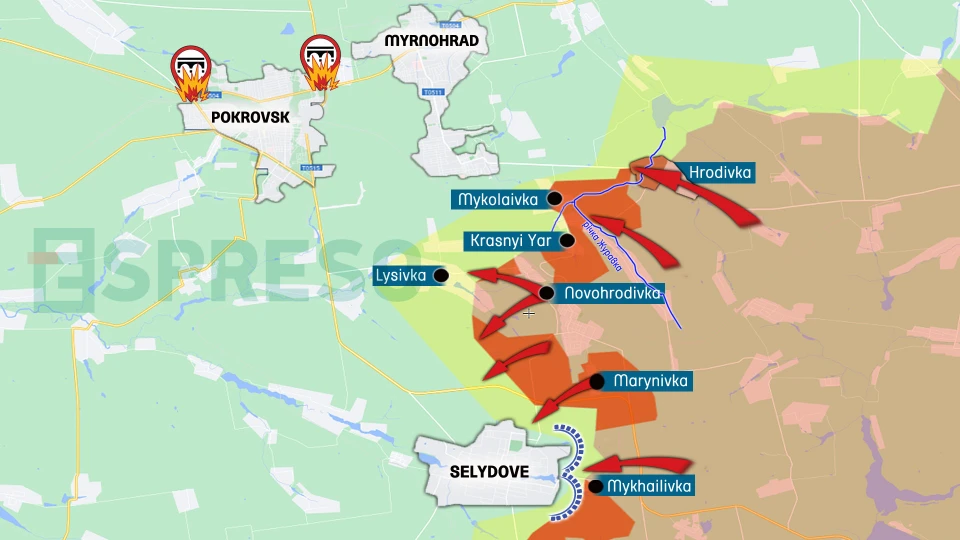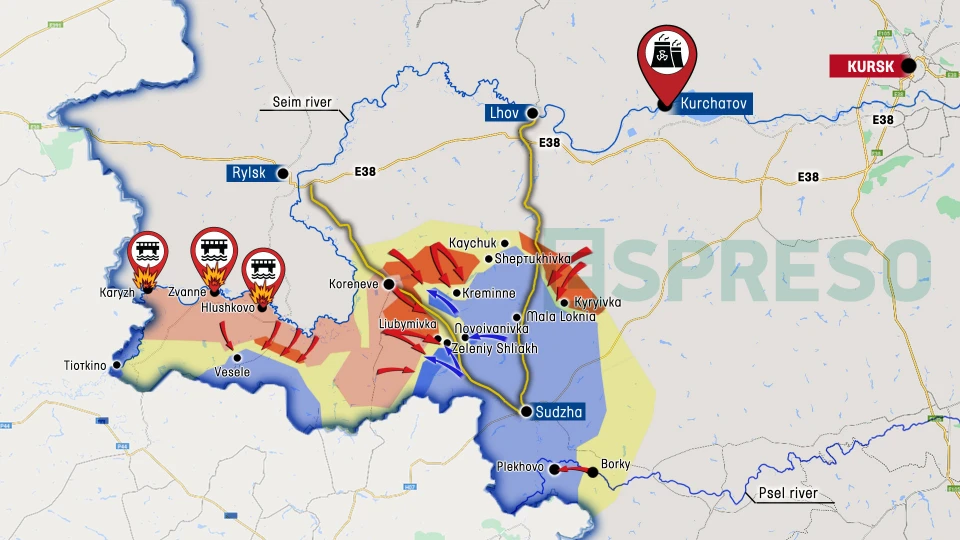
South Korea reviews cooperation with Ukraine in supplying weapons for offense and defense. Serhiy Zgurets's column
South Korea produces everything from ballistic missiles, aircraft, tanks, guns, ammunition, and everything is of a fairly good quality. And their systems, which are similar to HIMARS, compete with American weapons in certain markets
The situation at the front
I will highlight only certain areas on the front line that I consider to be the most tense, foremost, Pokrovsk and Kurakhove. The dynamics in the Pokrovsk sector is determined by the fighting around Selydove. Here, Russia is launching frontal attacks on the town and trying to cut off the connection to this settlement, in particular, to the Selydove-Pokrovsk road. They are also trying to break through to Vyshneve to cut another supply line to Selydove. Ukraine's 15th National Guard Brigade Kara-Dag is currently stationed there, and difficult fighting is ongoing.

On October 21, there were reports that 273 Russian soldiers were eliminated in one direction alone near Selydove. That is, half were killed, half were wounded, but these are insane figures for the Russian offensive forces, although they continue trying to use artillery, aviation and their usual tactics.
Let's also mention the Kurakhove direction, because after capturing Vuhledar, Russia regrouped its forces. Now the entire frontline, from Zolota Nyva to Kurakhivka, is under Russia's pressure.
On the map, there are directions to Katerynivka, Kostiantynivka, Maksymilianivka and beyond, where Russia is using armored vehicles. We have repeatedly shown how Ukraine's 46th Separate Airmobile Brigade and the 79th Separate Air Assault Brigade destroy Russian armored columns. And on October 22, the video was shown by the 33rd Separate Mechanized Brigade, which holds the area between these two brigades. A Ukrainian Leopard 2A4 tank is operating there quite effectively, ambushing Russian offensive armored vehicles.
Russian armored vehicles explode. It's clearly seen that Ukrainian tanks are maneuvering effectively, which means that the capabilities of foreign equipment are quite effective in fighting Russian armor. But when I look at such videos and see one of Ukraine's tanks, my heart bleeds, because I think these are very dangerous actions using one tank. But the Ukrainian military probably knows and assesses these risks on the battlefield.
Speaking of tanks, another interesting video has emerged from Ukraine's 47th Separate Mechanized Brigade operating in the Kursk sector. This video demonstrates the capabilities of Ukrainian Abrams and Bradley tanks used by the 47th Brigade.
This is an area in the Novoivanivka zone, and the direction that Russians claimed they were already there and dominating. But in fact, this video confirms that they are not there, or that it is a "gray zone". Novoivanivka is located along the Korenevo-Sudzha road, and this area is one of the hottest compared to other areas.

Why is it important to use armored vehicles and tracked vehicles now? Because when it starts to rain, wheeled vehicles have certain disadvantages, and tracked vehicles, such as IFVs and tanks, come to the fore. The 47th Brigade demonstrates this, showing how effectively this foreign equipment can be used against the enemy.
South Korea's reaction to the DPRK military at the front
Meanwhile, Russia has relied on manpower, in particular, on North Korea's foreign manpower. It is promised that soon a certain number of thousands of North Korean troops will appear on the front line. This was a significant impetus for South Korea to reconsider its plans for cooperation with Ukraine. A number of South Korean governmental and non-governmental publications reported that the country's leadership is reviewing the prospects for cooperation with Ukraine in order to assess and supply weapons for offense and defense.
We know that South Korea's defense industry is self-sufficient. This country produces everything from ballistic missiles, aircarft, tanks, guns, ammunition, and it is of a fairly good quality. Sometimes, for certain models, when talking about tactical missiles, systems similar to HIMARS, they compete with American weapons in certain markets. For example, Poland buys a significant amount of South Korean weapons to equip its army.
But what does Ukraine need first and foremost, and what does South Korea have, if we don't talk about long-range weapons? I think it will be difficult with long-range weapons, but South Korea has significant stockpiles of ammunition. In particular, when it comes to 105 mm caliber, they have about 3 million rounds of ammunition for 105 mm guns that were previously accumulated and are not used now. This is something that can be transferred to Ukraine.
Another interesting and important story is that South Korea has a significant amount of Soviet equipment. At one time, Russia paid off its debts to South Korea with weapons, so there are T-80 tanks and a significant number of different types of armored personnel carriers. This is something that can be transferred to Ukraine.
Ukraine's defense industry
Of course, we are talking about foreign weapons, but Ukraine must rely on its own defense industry. Now let's talk about whether Ukraine's defense industry is really working at the highest possible pace, as required by the realities and the war.
Ihor Fomenko, Director General of the Federation of Employers of Ukraine Defense, Deputy Minister of Economy of Ukraine (2022-2024), said that today the utilization of production capacity in the domestic defense industry is about 40%. There are companies that are 100% utilized, and there are companies that are idle. The main reason for this is the lack of financial resources to buy back the weapons produced by the Ukrainian defense industry. There are three priorities in the industry today. The first is long-term planning, because the technological cycle is 6-9 months and even longer for some complex weapons, so it is crucial to have three-year contracts to plan the necessary resources. Now there is a trend to sign three-year contracts. The second is the 40% workload in the industry and the lack of financial resources. If we translate this into money, we have $10 billion of production capacity that is not being utilized. The third is access to preferential lending. The state has a program of affordable loans called “5-7-9” for everyone except the defense sector.
The Director General noted that on September 18, the Verkhovna Rada adopted the relevant amendments to the 2024 budget, which the President signed. Therefore, it is hoped that at the next government meeting, the procedure for compensating interest for banks, as well as amendments to the resolution on portfolio guarantees, will be adopted, which will allow enterprises to receive financial resources for development and working capital at 5%. This will allow for a more structured procurement campaign and lower prices for the end user, the Security and Defense Forces of Ukraine.
The former Minister of Economy explained that the amendments to the state budget include UAH 263 million for 2024, which is about UAH 2.5-3 billion of credit resources to be used this year. It is important that the government adopts the relevant regulations so that businesses have time to take advantage of this program. Next year, UAH 2.5 billion is envisaged, which is 10 times more. Approximately UAH 25-30 billion will be available for concessional lending. Of course, this is not enough, but, realizing that there is not enough money, the state budget will compensate for this interest rate. Therefore, this is a good solution. Let's hope that every year this amount in the state budget will only increase.
Fomenko believes that the state must be confident in its control over some defense industry subsectors in terms of leakage of critical technologies or key competencies. However, the future belongs to private business, but the state must control the technologies that will compete in the global market after the war. If you look at the field of unmanned systems, how many state-owned enterprises have developed UAVs and how many have developed private businesses? We can count up to 10 from state-owned enterprises, but hundreds and hundreds from private sector companies, because they are more flexible and quick to make decisions. So today, public-private partnerships are a good story, but this balance must be maintained.
- News












































